| Red Storm Rising: INDO-PACOM China Military Projection
红色风暴:美国印度-太司洋令部中国军事计划 Date:2020-10-06 Source:FAS By:Globalmil Viewed: |
Posted on Sep.15, 2020 in China, Nuclear Weapons, Pacific Ocean, United States by Hans M. Kristensen
美国汉斯·克里斯滕森(Hans M.Kristensen)发表于2020年9月15日在中国,核武器,太平洋地区
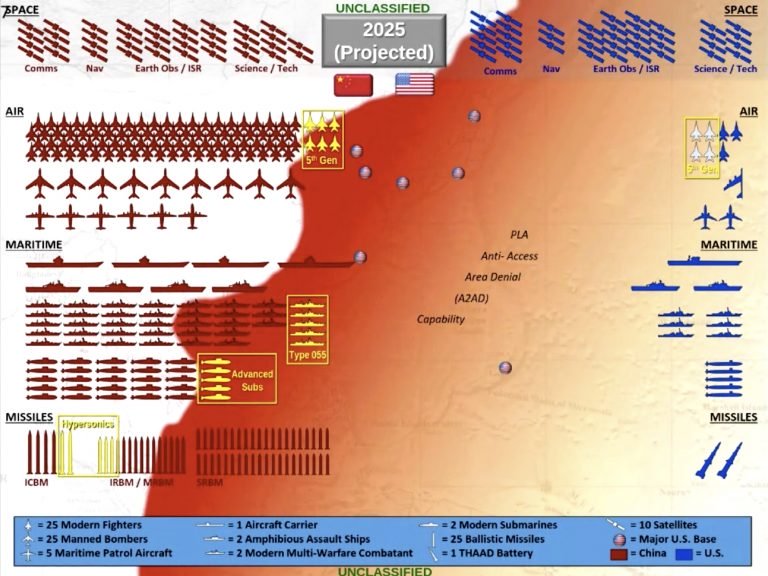
Some Missile Numbers Do Not Match Recent DOD China Report
一些导弹数量与最近的国防部《中国报告》不符
By Hans M. Kristensen
汉斯·克里斯滕森(Hans M.Kristensen)
U.S. Indo-Pacific Command recently gave a briefing about the challenges the command sees in the region. The briefing says China is the “Greatest Threat to Global Order and Stability” and presents a set of maps that portray a massive Chinese military buildup and very little U.S. capability (and no Allied capability at all) to counter it. With its weapons icons and a red haze spreading across much of the Pacific, the maps resemble a new version of the Cold War classic Red Storm Rising.
美国印度-太平洋司令部最近简要介绍了该司令部在该地区遇到的挑战。简报说,中国是“对全球秩序和稳定的最大威胁”,并提出了一系列地图,描绘了中国庞大的军事力量和很少的美国能力(根本没有盟军的能力)来对付它。 这些地图的武器图标和红色雾霾散布在太平洋的大部分地区,类似于冷战经典《红色风暴(Red Storm Rising)》的新版本。
Unfortunately, the maps are highly misleading. They show all of China’s forces but only a fraction of U.S. forces operating or assigned missions in the Pacific.
不幸的是,这些地图极具误导性。 它们显示了中国所有的部队,但只显示了一部分在太平洋行动或分配任务的美军。
There is no denying China is in the middle of a very significant military modernization that is increasing its forces and their capabilities. This is and will continue to challenge the military and political climate in the region. For decades, the United States enjoyed an almost unopposed – certainly unmatched – military superiority in the region and was able to project that capability against China as it saw fit. The Chinese leadership appears to have concluded that that is no longer acceptable and that the country needs to be able to defend itself.
不可否认的是,中国正处于非常重要的军事现代化进程之中,正在增加其力量和能力。并将继续挑战该地区的军事和政治气候。几十年来,美国在该地区几乎享有无与伦比的军事优势,甚至可以说是无人能敌的,并且能够将这种能力投射到它认为合适的位置。中国领导人似乎已经得出结论,那就是,这不再是可以接受的,而且中国需要能够捍卫自己。
In describing this development, however, the INDO-PACOM briefing slides make the usual mistake of overselling the threat and under-characterizing the defenses. Moreover, some of the Chinese missile forces listed in the briefing differ significantly from those listed in the recent DOD report on Chinese military developments. As military competition and defense posturing intensify, expect to see more of these maps in the future.
但是,在描述这种发展时,印度-太平洋司令部(INDO-PACOM)简报幻灯片犯了通常的错误,即过度夸大了威胁并低估了防御能力。此外,简报中列出的一些中国导弹力量与国防部最近关于中国军事发展的报告中列出的那些有很大不同。随着军事竞争和国防态势的加剧,希望将来能看到更多此类地图。
Apples, Oranges, and Cherry-Picking
苹果,橙子和樱桃采摘
The INDO-PACOM maps suffer from the same lopsided comparison and cherry-picking that handicapped the 2018 Nuclear Posture Review: it overplays the Chinese capabilities and downplays the U.S. capabilities (see image below). While he briefing maps includes all of China’s military forces, whether they are postured toward India or Russia, it only shows a small portion of U.S. forces. INDO-PACOM mapmakers may argue that it’s only intended to show the force level in the Western Pacific theater, but INDO-PACOM spans all of the Pacific and the maps ignore other significant U.S. forces that are operating in the region to oppose China.
印度-太平洋司令部(INDO-PACOM)地图遭受了同样的不平衡对比和挑剔,这阻碍了2018年《核态势评估》的发展:它夸大了中国的能力而低估了美国的能力(见下图)。他的简报地图包括了中国所有的军事力量,无论他们是对印度还是对俄罗斯,都只展示了一小部分美国军队。印度-太平洋司令部(INDO-PACOM)制图师可能会争辩说,它只是为了显示西太平洋战区的兵力水平,但是印度-太平洋司令部(INDO-PACOM)跨越了整个太平洋地区,这些地图忽略了在该地区作战用于对抗中国的其他重要美国军队。
The INDO-PACOM map gives the impression that the United States only has 175 fighter-jets, 12 bombers, 50 maritime patrol aircraft, 1 aircraft carrier, four amphibious assault ships, 12 modern multi-warfare warships, 10 submarines, and 2 THAAD missile defense batteries in the region to deter China. In reality, the U.S. military forces based or assigned missions in the INDO-PACOM area of responsibility are significantly greater. The map excludes everything based in Hawaii, in Alaska, on the U.S. west coast, and elsewhere in the continental United States with missions in the Pacific or forces rotating through bases in the Indo-Pacific region. Examples of mischaracterizations of U.S. forces include:
印度-太平洋司令部(INDO-PACOM)地图给人的印象是,美国在该地区只有175架战斗机,12架轰炸机,50架海上巡逻机,1艘航空母舰,4艘两栖攻击舰,12艘现代化多用途战舰,10艘潜艇和2个萨德(THAAD)导弹防御连队威慑中国。事实上,美国军队在印度-太平洋司令部的责任范围内的任务要大得多。该地图不包括位于夏威夷,阿拉斯加,美国西海岸以及美国大陆其他地区,在太平洋执行任务或在印度太平洋地区基地轮换的部队。对美军的错误描述包括:
Fighter aircraft: The map lists only lists 175 fighter-jets, but Pacific Air Forces says it has “Approximately 320 fighter and attack aircraft are assigned to the command with approximately 100 additional deployed aircraft rotating on Guam.”
战斗机:该地图只列出了175架战斗机,但是太平洋空军说:“已经向该司令部分配了约320架战斗机和攻击机,另外还有约100架部署在关岛的旋翼飞机。”
Bombers: The map lists only 12 bombers, but the United States has more than 150 bombers, many of which would be used to counter Chinese forces in a war. Moreover, those bombers are considerably more capable than Chinese bombers and are supported by tankers to provide unconstrained range in the Pacific, something Chinese bombers cannot do.
轰炸机:地图上只列出了12架轰炸机,但美国拥有150多架轰炸机,其中许多将用于在战争中对付中国军队。而且,这些轰炸机比中国轰炸机要强大得多,并得到了加油机的支持,可以在太平洋提供不受限制的航程,这是中国轰炸机无法做到的。
Submarines: The map lists only 10 U.S. submarines, but according to the U.S. Naval Vessel Register the U.S. Navy has more than three times that many (35) in the Pacific, including 25 attack submarines, 2 guide missile submarines, and 8 ballistic missile submarines (SSBNs) homeported in Pacific ports. The omission of the 8 Pacific-based SSBNs is particularly problematic given their important role of targeting China – and that they are assigned up to eight times more nuclear warheads than China has in its entire nuclear weapons stockpile.
潜艇:该地图仅列出了10艘美国潜艇,但根据美国海军船只登记册,美国海军在太平洋地区的潜艇数量是地图列明的三倍(35艘),其中包括25艘攻击潜艇,2艘导弹潜艇和8艘弹道导弹潜艇(SSBN),部署到太平洋港口。考虑到它们在瞄准中国方面的重要作用,因此忽略了太平洋上8艘弹道导弹核潜艇(SSBN)尤其成问题-而且它们被分配的核弹头数量是中国整个核武器储备中核弹头数量的8倍。
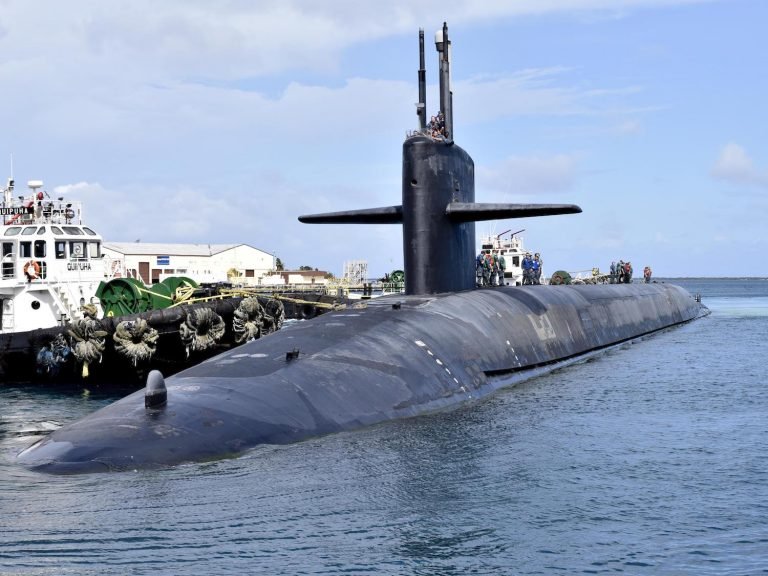
The INDO-PACOM briefing does not show that the United States has any ballistic missile submarines in the Pacific, even though eight U.S. Pacific-based SSBNs play a central role in targeting China. Just two of these Ohio-class SSBNs can carry more warheads than China has in its entire nuclear stockpile. This image shows the USS Pennsylvania (SSBN-735) during a port visit to Guam in 2016.
印度-太平洋司令部(INDO-PACOM)简报并未显示出美国在太平洋地区拥有任何弹道导弹潜艇,尽管有8艘位于美国太平洋的弹道导弹核潜艇(SSBN)在瞄准中国方面发挥了核心作用。这些俄亥俄级弹道导弹核潜艇(SSBN)中,同样的两艘能够携带的弹头就比中国整个核储存中的弹头多。此图显示了2016年对关岛进行港口访问期间的宾夕法尼亚号(USB Pennsylvania)(SSBN-735)。
Aircraft carriers: The map lists only one U.S. aircraft carrier, but according to the U.S. Naval Vessel Register the U.S. Navy has six aircraft carriers based in the Pacific (two of them in shipyard). Moreover, unlike China’s single aircraft carrier (a second is fitting out), U.S. carriers are large flat-tops with more aircraft.
航空母舰:该地图仅列出一艘美国航空母舰,但根据美国海军船只登记册,美国海军在太平洋有六艘航空母舰(其中两艘在造船厂)。而且,与中国的一艘航母不同(第二艘正在装配中),美国的航母是大型航空母舰,拥有更多的飞机。
Amphibious assault ships: The map shows four U.S. amphibious assault ships, but the U.S. Pacific Fleet says it operates six (although one was recently damaged by fire). Moreover, the amphibious assault ships are being upgraded to carry the F-35B VSTOL aircraft, significantly improving their strike capability.
两栖攻击舰:该地图显示了四艘美国两栖攻击舰,但美国太平洋舰队表示其有六艘(尽管其中一艘最近遭到火灾损坏)。此外,两栖攻击舰正在升级,以搭载F-35B垂直和短距起落飞机(VSTOL)飞机,从而大大提高了其打击能力。
Missile defense: The map shows only two THAAD batteries but does not mention the Ground Based Midcourse missile defense system in Alaska. Nor are missile defense interceptors deployed on cruisers and destroyers listed.
导弹防御:该地图仅显示了两个萨德(THAAD)连队,但未提及阿拉斯加的地面中段导弹防御系统。没有列出部署在巡洋舰和驱逐舰上的导弹防御拦截器。
ICBMs: One of the most glaring omissions is that the maps do not show the United States has any ICBMs (the map also does not list U.S. SLBMs but nor does it list Chinese SLBMs). Although U.S. ICBMs are thought to be mainly assigned to targeting Russia and would have to overfly Russia to reach targets in China, that does not rule out they could be used to target China (Chinese ICBMs would also have to overfly Russia to target the continental United States). U.S. ICBMs carry more nuclear warheads than China has in its entire nuclear stockpile.
洲际弹道导弹:最明显的遗漏之一是这些地图没有显示美国有洲际弹道导弹(该地图也没有列出美国的潜射弹道导弹(SLBM),也没有列出中国的潜射弹道导弹(SLBM))。尽管人们认为美国洲际弹道导弹主要是针对俄罗斯,并且必须飞越俄罗斯才能达到中国的目标,但这并不排除它们可以用来瞄准中国(中国洲际弹道导弹也必须飞越俄罗斯以瞄准美国本土)。美国洲际弹道导弹携带的核弹头数量超过了中国的全部核储备。
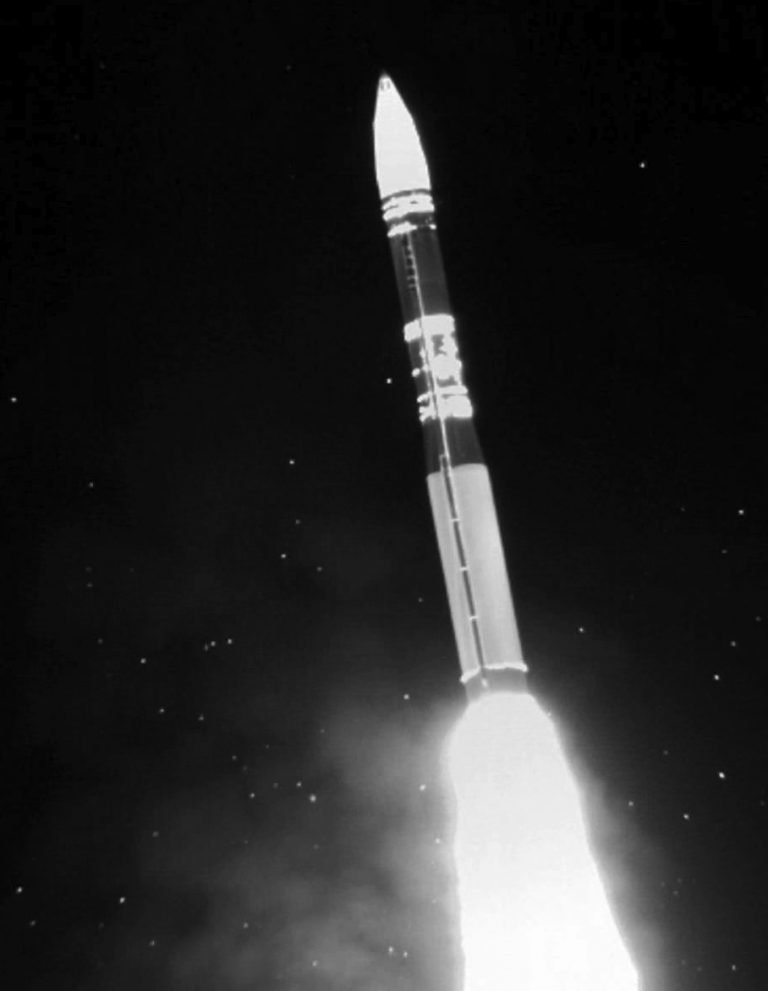
The INDO-PACOM briefing shows China with 100 ICBMs and the United States with none. This infrared image shows a U.S. Minuteman III ICBM test-launched from Vandenberg AFB into the Pacific on September 2, 2020.
印度-太平洋司令部(INDO-PACOM)简报显示,中国有100枚洲际弹道导弹,美国没有。这张红外图像显示了2020年9月2日从范登堡空军基地向太平洋发射的美国民兵III型洲际弹道导弹。
A modified map, apparently made available by U.S. Pacific Air Forces, is a little better because it includes Australian, Japanese, and South Korean forces. But it still significantly mischaracterizes the forces the United States has in the Pacific or are assigned missions in the region. Moreover, the new map does not include the yellow highlights showing “hypersonics” missiles and portion of aircraft, ships, and submarines that are modern (see modified map below).
显然由美国太平洋空军提供的经过修改的地图要好一些,因为它包括澳大利亚,日本和韩国的军队。但这仍然严重地歪曲了美国在太平洋地区或分配给该地区任务的军事力量。此外,新地图未包括黄色高亮显示部分,这些黄色高亮显示了“高超音速”导弹以及现代飞机,舰艇和潜艇的一部分(请参见下面的修改后的地图)。
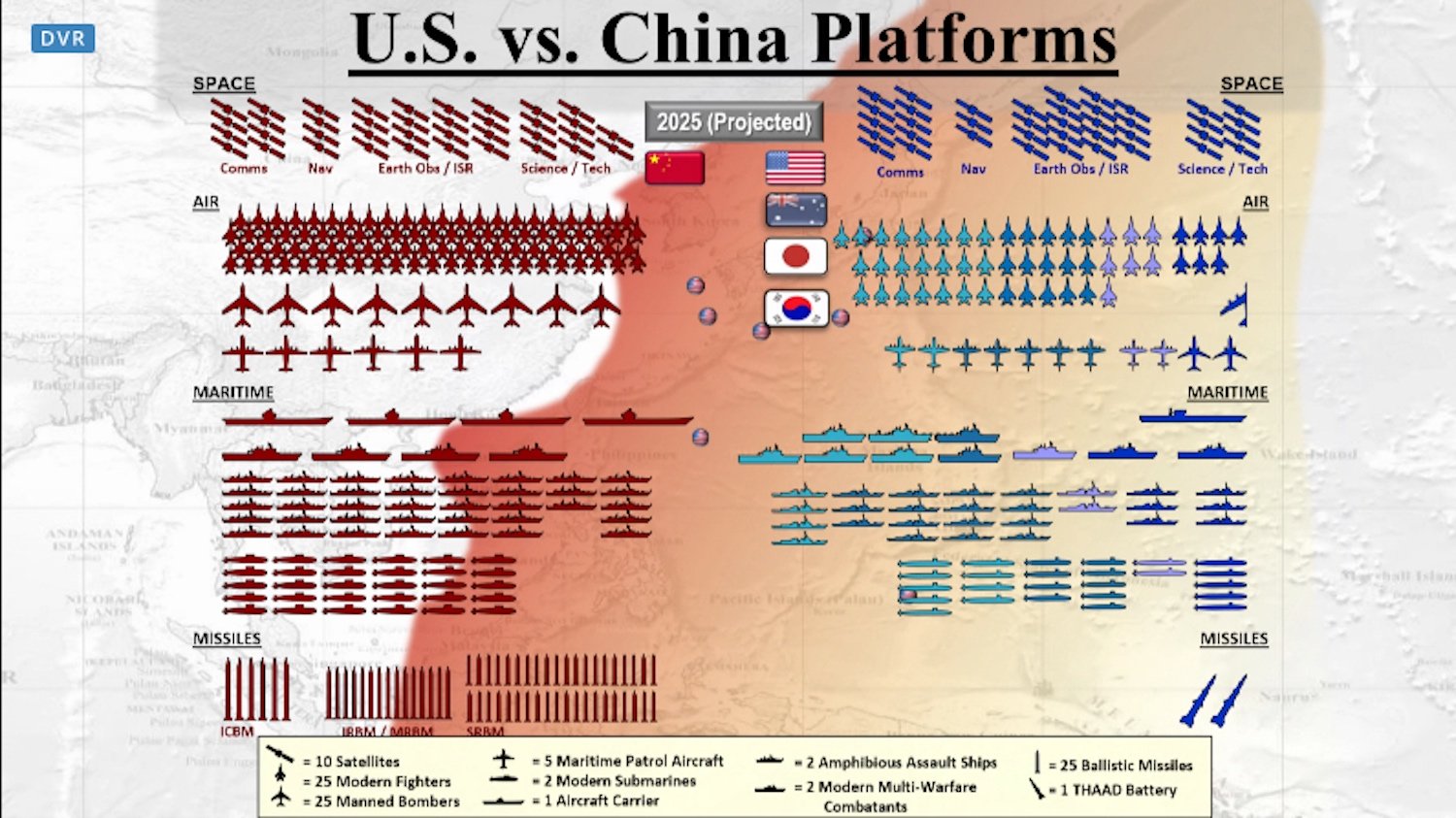
A modified map released after the INDO-PACOM briefing also shows Australian, Japanese, and South Korean forces – but still mischaracterizes U.S. military forces in the Pacific.
在印度-太平洋司令部(INDO-PACOM)简报后发布修改后的地图还显示了澳大利亚,日本和韩国的部队,但仍然错误地描述了美国在太平洋的军事力量。
Inconsistent Missile Numbers
导弹编号不一致
The INDO-PACOM maps are also interesting because the numbers for Chinese IRBMs and MRBMs are different than those presented in the 2020 DOD report on Chinese military developments. INDO-PACOM lists 250 IRBMs/MRBMs, more than 100 missiles fewer than the DOD estimate. China has fielded one IRBM (DF-26), a dual-capable missile that exists in two versions: one for land-attack (most DF-26s are of this version) and one for anti-ship attack. China operates four versions of the DF-21 MRBM: the nuclear DF-21A and DF-21E, the conventional land-attack DF-21C, and the conventional anti-ship DF-21D.
印度-太平洋司令部(INDO-PACOM)地图也很有趣,因为中国的远程弹道导弹(IRBM)和中程弹道导弹 (MRBM)的数量与2020年国防部关于中国军事发展的报告中列出的数量不同。印度-太平洋司令部(INDO-PACOM)列出了250枚IRBM/MRBM,比国防部估计的少100多枚导弹。中国已部署了一枚IRBM(DF-26,东风-26),这是一种具有双重能力的导弹,有两种型号:一种用于对地攻击(大多数DF-26都属于该型号),另一种用于反舰攻击。中国使用的是DF-21 MRBM的四种型号:核能力DF-21A和DF-21E,常规对地攻击DF-21C和常规反舰DF-21D。
There is also a difference in the number of SRBMs, which INDO-PACOM sets at 1,000, while the DOD report lists 600+. The 600+ could hypothetically be 1,000, but the INDO-PACOM number shows that the high-end of the 750-1,500 range reported by the 2019 DOD China report probably was too high.
短程弹道导弹 (SRBM)的数量也存在差异,印度-太平洋司令部(INDO-PACOM)设定为1,000枚,而国防部(DOD)报告列出了600+。 假设600+可能为1,000,但是印度-太平洋司令部(INDO-PACOM)数据显示,2019年国防部(DOD)中国报告所报告的750-1,500范围中的上限部分可能太高了。
A comparison (see table below) is complicated by the fact that the two reports appear to use slightly different terminology, some of which seems inconsistent. For example, INDO-PACOM lists “missiles” but the low IRBM/MRBM estimate suggests it refers to launchers. However, the high number of SRBMs listed suggest it refers to missiles.
由于这两个报告使用的术语略有不同,因此有些比较(请参阅下表)变得很复杂,其中有些似乎不一致。 例如,印度-太平洋司令部(INDO-PACOM)列出了“导弹”,但较低的IRBM/MRBM估计值表明它是指发射装置。但是,列出的大量SRBM表示它是指导弹。
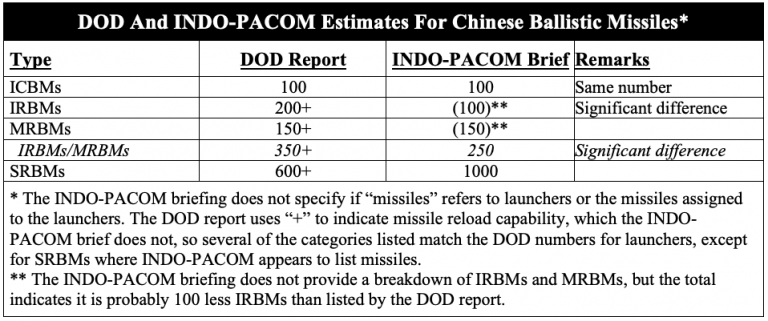
Several of the Chinese missile estimates provided by INDO-PACOM and DOD are inconsistent.
印度-太平洋司令部(INDO-PACOM)和美国国防部(DOD)提供的一些中国导弹估算不一致。
2025 Projection
2025年预测
The projection made by INDO-PACOM for 2025 shows significant additional increases of Chinese forces, except in the number of SRBMs.
印度-太平洋司令部(INDO-PACOM)对2025年的预测表明,除了短程弹道导弹 (SRBM)的数量外,中国军队还将显着增加。
The ICBM force is expected to increase to 150 missiles from 100 today. That projection implies China will field an average of 10 new ICBMs each year for the next five years, or about twice the rate China has been fielding new ICBMs over the past two decades. Fifty ICBMs corresponds to about four new brigades. About 20 of the 50 new ICBMs are probably the DF-41s that have already been displayed in PLARF training areas, military parades, and factories. The remaining 30 ICBMs would have to include more DF-41s, DF-31AGs, and/or the rumored DF-5C, but it seems unlikely that China can add enough new ICBM brigade bases and silos in just five years to meet that projection.
预计洲际弹道导弹的力量将从现有的100枚增加到150枚。 该预测表明,未来五年,中国平均每年将部署10枚洲际弹道导弹,这是过去二十年来中国部署新洲际弹道导弹速度的两倍。五十枚洲际弹道导弹对应大约四个新旅。在50枚新型洲际弹道导弹中,大约有20枚可能是DF-41,已经在中国火箭军(PLARF)训练区,阅兵场和工厂展出。 剩下的30枚洲际弹道导弹将必须包括更多的DF-41,DF-31AG和/或传闻中的DF-5C,但是中国似乎不可能在短短五年内增加足够的新洲际弹道导弹旅基地和发射井来满足这一预测。
The briefing also projects that 50 of the 150 ICBMs by 2025 will be equipped with “hypersonics.” The reference to “hypersonics” as something new is misleading because existing ICBMs already carry warheads that achieve hypersonic speed during reentry. Instead, the term “hypersonics” probably refers to a new hypersonic glide vehicle. It is unclear from the briefing if INDO-PACOM anticipates the new payload will be nuclear or conventional, but a conventional ICBM payload obviously would be a significant development with serious implications for crisis stability. Even if this expansion comes true, the entire Chinese ICBM force would only be one-third of the size of the U.S. ICBM force. Nonetheless, a Chinese ICBM force of 100-150 is still a considerable increase compared with the 40 or so ICBMs it operated two decades ago (see graph below).
简报还预测,到2025年,在150枚洲际弹道导弹中,有50枚将配备“ 高超音速(hypersonics)”弹头。 将“高超音速( hypersonics)”作为新的说法是令人误解的,因为现有的洲际弹道导弹已经携带弹头,可在再进入时达到超音速。 取而代之的是,“ hypersonics”一词可能是指一种新的高超音速滑翔飞行器。 从简报中尚不清楚,印度-太平洋司令部(INDO-PACOM)是否预计的新有效载荷将是核载荷还是常规载荷,但常规的洲际弹道导弹载荷显然将是一项重大发展,对危机的稳定性产生严重影响。 即使实现这种扩张,整个中国洲际弹道部队的规模也仅是美国洲际弹道部队规模的三分之一。 但是,中国的洲际弹道导弹力量为100-150枚,与二十年前的40枚左右洲际弹道导弹相比,仍是一个相当大的增长(见下图)。
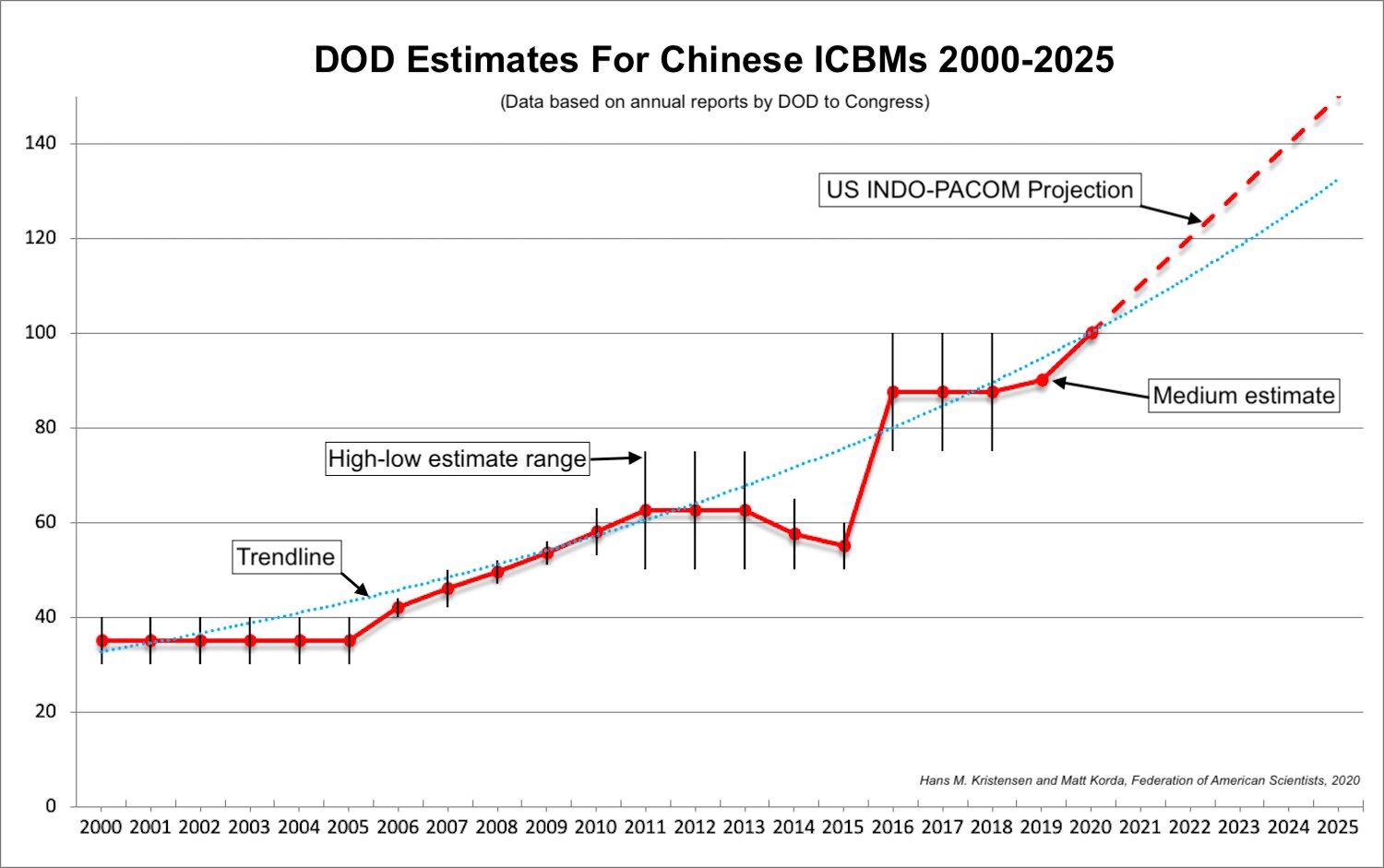
The INDO-PACOM briefing appears to show a greater increase in ICBMs projected for the next five years than DOD reported in the past decade.
印度-太平洋司令部(INDO-PACOM)简报似乎表明,未来五年洲际弹道导弹的增长将比国防部过去十年报告的更大。
The IRBM/MRBM force is projected to increase to 375, from 250 today. That projection assumes China will field 125 additional missiles over five years, or 25 missiles each year. That corresponds to a couple of new brigades per year, which seems high. Yet production is significant and IRBM launchers have been seen in several regions in recent years. The IRBM/MRBM force presumably would include the DF-17, DF-21, and the DF-26.
IRBM/MRBM兵力预计将从今天的250枚增加到375枚。该预测假设中国将在五年内增加部署125枚导弹,或每年25枚。这相当于每年增加几个新的旅,这似乎很高。然而,生产量非常可观,近年来,已经在多个地区看到了IRBM发射装置。IRBM/MRBM兵力大概包括DF-17,DF-21和DF-26。
About 75-87 of the IRBM/MRBM force will be equipped with “hypersonics” by 2025, according to INDO-PACOM. That projection probably refers to the expected fielding of the DF-17 with a new glide-vehicle payload, although that would imply a lot of the new launcher (enough for 4-6 brigades). Another possibly is that a portion of other IRBMs/MRBMs (perhaps the DF-26) might also be equipped with the new payload or have their own version. China has presented the DF-17 as conventional but STRATCOM has characterized it as a “new strategic nuclear system.” Adding new hypersonics to IRBMs/MRBMs that are already mixing nuclear and conventional seems extraordinarily risky and likely to further exacerbate the danger of misunderstandings.
根据印度-太平洋司令部(INDO-PACOM)的数据,到2025年,大约75-87枚的IRBM MRBM力量将配备“高超音速( hypersonics)”。 该预测可能是指DF-17预期配备新滑翔飞行器有效载荷的情况,尽管这将暗示很多新发射装置(足够4-6个旅使用)。另一个可能是其他IRBM/MRBM(也许是DF-26)的一部分也可能配备了新的有效载荷或拥有自己的型号。中国曾将DF-17列为常规武器,但美国战略司令部(STRATCOM)将其定性为“新型战略核系统”。在已经将核武器和常规武器混为一谈的IRBM/MRBM中增加新的高超音速飞行器似乎是非常危险的,而且可能会进一步加剧误解的危险。

The INDO-PACOM does not list any DF-17s but projects that 75-87 of China’s IRBMs/MRBMs by 2025 will carry some form of hypersonic payload that is different from what they carry today.
印度-太平洋司令部(INDO-PACOM)没有列出任何DF-17,但预计到2025年,中国75-87枚的IRBM/MRBM将携带某种形式的超音速有效载荷,这与它们目前所携带的不同。
The status and projection for the surface fleet are also interesting. The INDO-PACOM briefing lists the total number of aircraft carriers, amphibious assault ships, and modern multi-warfare combatant vessels at 54, of which 46 are modern multi-warfare combatant vessels. The briefing doesn’t specify what is excluded from this count, but it differs significantly from the count in the DOD China report.
地面舰队的状态和预测也很有趣。 INDO-PACOM简报列出了航空母舰,两栖攻击舰和现代化多用途战斗舰的总数,共54艘,其中46艘是现代化多用途战斗舰。简报中没有指定排除在此计数范围之外的内容,但与美国防部中国报告中的计数存在明显差异。
One of the puzzling parts of the INDO-PACOM briefing is the projection that China by 2025 will be operating four aircraft carriers for fixed-wing jets. China is currently operating one carrier with a second undergoing sea-trials. How China would be able to add another three carriers in five years is a mystery, not least because the third and fourth hulls are of a new and more complex design. The projection also doesn’t fit with the U.S. Office of Naval Intelligence, which predicts the third carrier won’t be commissioned until 2024.
印度-太平洋司令部(INDO-PACOM)简报中令人费解的部分之一是,预计到2025年,中国将部署四艘携带固定翼飞机的航空母舰。中国目前正在部署一艘航母,其中第二艘正在进行海试。中国如何在五年内增加三艘航母是一个谜,这主要是因为第三和第四艘船体采用了新的,更复杂的设计。该预测也与美国海军情报局不符,后者预测第三艘航母要到2024年才能服役。
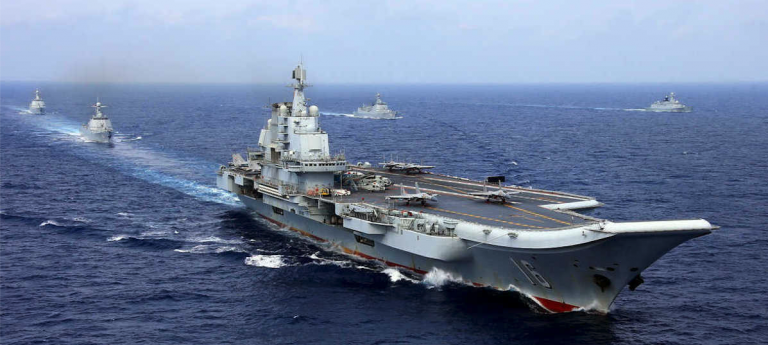
The INDO-PACOM briefing says China will operate four aircraft carriers by 2025 but ONI estimates the third won’t be commissioned until 2024.
印度-太平洋司令部(INDO-PACOM)简报说,到2025年,中国将部署四艘航空母舰,但印度情报局(ONI)估计,第三艘将在2024年之前服役。
Bombers are projected to increase from 175 today to 225 in 2025, an increase of nearly 30 percent. Since 2025 is probably too early for the new H-20 to become operational, the increase appears to only involve modern version of the H-6 bomber. Although the bomber force has recently been reassigned a nuclear mission, the majority of the Chinese bomber force will likely continue to be earmarked for conventional missions.
到2025年轰炸机预计将从现有的175架增加到225架,增长近30%。由于2025年对于新的H-20服役可能为时过早,因此增加似乎只涉及现代化型号的H-6轰炸机。尽管轰炸机部队最近已被重新分配了一项核任务,但大多数中国轰炸机部队仍将继续被指定用于常规任务。
Submarines and surface vessels will also increase and some of them are being equipped with long-range missiles. Combined with the growing reach of ground-based ballistic missiles and air-delivered cruise missiles, this results in the INDO-PACOM maps showing a Chinese “anti-access area denial” (A2AD) capability bleeding across half of the Pacific well beyond Guam toward Hawaii. But A2AD is not a bubble and weakens significantly in areas further from Chinese shores.
潜艇和水面舰艇也将增加,其中一些正在装备远程导弹。再加上陆基弹道导弹和空中巡航导弹的不断增长的影响,这导致了印度-太平洋司令部(INDO-PACOM)地图,该地图显示了中国“反介入区域封锁”(A2AD)能力在关岛以外太平洋的一半地区趋向夏威夷。但是,“反进入区域封锁”(A2AD)并非泡沫,在距中国海岸较远的地区会大大减弱。
Conclusion and Recommendations
结论与建议
The INDO-PACOM maps project China’s military modernization will continue at a significant pace over the next five years with increases in delivery platforms and capabilities. This will reduce the military advantage the United States has enjoyed over China for decades and further stimulate modernization of U.S. and allied military forces in the region. As forces grow, operations increase, and rhetoric sharpens, insecurity and potential incidents will increase as well and demand new ways of reducing tension and risks.
印度-太平洋司令部(INDO-PACOM)地图显示在未来五年内,随着交付平台和能力的增加,中国的军事现代化将继续以显着速度发展。这将削弱美国数十年来在中国享有的军事优势,并进一步刺激美国和该地区盟军的现代化。随着部队的增加,行动的增加和言语的尖锐化,不安全感和潜在事件也将增加,因此需要新的方式来减轻紧张局势和风险。
The Trump administration is correct that China should be included in talks about limiting forces and reducing tension. So far, however, the administration has not presented concrete ideas for what that could look like. Like the United States, China will not accept limits on its forces and operations without something in return that Beijing sees as being in its national interest. Although China is modernizing its nuclear forces and appears intent on increasing it further over the next decade, the force will remain well below the level of the United States and Russia for the foreseeable future. Insisting that China should join U.S.-Russian nuclear talks seems premature and it is still unclear what the United States would trade in return for what. In the near-term, it seems more important to try to reach agreements on limiting the increase of conventional forces and operations.
特朗普政府的正确做法是,应该将中国纳入限制力量和减轻紧张局势的谈判中。但是,到目前为止,政府尚未就可能出现的情况提出具体想法。像美国一样,如果没有北京认为符合其国家利益的回报,中国就不会接受对其部队和行动的限制。尽管中国正在使核力量现代化,并有意在未来十年进一步增加其核力量,但在可预见的将来,核力量仍将远远低于美国和俄罗斯的水平。坚持认为中国应该参加美俄核谈判还为时过早,目前还不清楚美国将以什么换取什么。在短期内,尝试就限制常规部队和行动的增加达成协议似乎更为重要。
Unfortunately, the INDO-PACOM briefing does a poor job in comparing Chinese and U.S. forces and suffers from the same flaw as the 2018 Nuclear Posture Review by cherry-picking and mischaracterizing force levels. It is tempting to think that this was done with the intent to play up the Chinese threat while downplaying U.S. capabilities to assist public messaging and defense funding. But the Chinese military modernization is important – as is finding the right response. Neither the public nor the Congress are served by twisted comparisons.
不幸的是,印度-太平洋司令部(INDO-PACOM)简报在比较中国和美国军队方面做得很差,并且由于挑剔和错误描述了军队的水平而遭受了与2018年《核态势评估》相同的缺陷。人们很容易以为,这样做是为了夸大中国的威胁,而淡化美国协助公共信息和国防资金的能力。但是,中国的军事现代化很重要-找到正确的对策也很重要。无论是公众和国会都不会受到歪曲比较的服务。
It would also help if the Pentagon and regional commands would coordinate and streamline their public projections for Chinese modernizations. Doing so would help prevent misunderstandings and confusion and increase the credibility of these projections.
如果五角大楼和地区司令部能够协调和精简他们对中国现代化的公众预测,这也会有所帮助。这样做将有助于防止误解和混淆,并提高这些预测的可信度。
Finally, these kinds of projections raise a fundamental question: why does the Pentagon and regional military commands issue public threat projections at all? That should really be the role of the Director of National Intelligence, not least to avoid that U.S. public intelligence assessments suffer from inconsistencies, cherry-picking, and short-term institutional interests.
最后,这些预测提出了一个基本问题:为什么五角大楼和地区军事司令部发布公共威胁预测?这实际上应该是国家情报总监的职责所在,尤其是要避免美国公共情报评估受到不一致,挑剔和短期机构利益的困扰。
This publication was made possible by generous contributions from the John D. and Catherine T. MacArthur Foundation, the New Land Foundation, the Ploughshares Fund, and the Prospect Hill Foundation. The statements made and views expressed are solely the responsibility of the authors.
这本书的出版是由约翰·D·和凯瑟琳·T·麦克阿瑟基金会、新土地基金会、犁铧基金会和展望山基金会慷慨捐助而成的。所作的陈述和发表的意见完全由作者负责。
上一篇:Winning: Chinese Fleet Is The Biggest 下一篇:US Army Views North Korean Military Tactics
| The Booker dilemma: inside US Army transformation
“布克”困境:美国陆军转型内幕 |
| The decision to cancel the M10 Booker light tank is at the core of a reordering of US Army planning.... [2025-07-16] |
| Focus: A fragile balance in Asia, China has become leading military power in the
焦点:亚洲平衡脆弱,中国已成为该地区的主要军事力量 |
| However, China's rapid military growth in this area is tipping the balance in favor of regional power. ... [2024-08-27] |
| Small drones will soon lose combat advantage, French Army chief says
法国陆军总司令表示,小型无人机将很快失去战斗优势 |
| By Rudy Ruitenberg Thursday, Jun 20, 2024 作者:鲁迪瑞滕伯格 2024年6月20日星期四 French Army Chief of Staff Gen. Pierre Schill inspecting a Rapid Eagle anti-drone system at the Eurosatory defense show in Paris on June 19, 202... [2024-08-18] |
| What’s next for Ukraine’s incursion into Russia?
乌克兰入侵俄罗斯的下一步是什么? |
| Ukraine’s forces have surprised us all with its recent incursion into Russia’s Kursk Oblast since the operation to turn the tide of the war,... [2024-08-17] |

